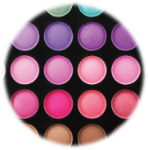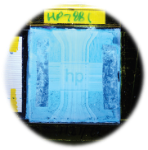____________________________________
Industrial Liaison Group:
Tel: +44 (0) 1235 778797
E-mail: [email protected]
Liquid crystal displays (LCDs) are currently very inefficient in terms of energy use. An electric field governs the direction of the liquid crystal molecules (which switches each pixel on or off) but currently a combination of polarisation filters and colour filters are used to view each pixel and provide colour. Each of these filters also block some of the light. The result is that only approximately 9% of the backlight is emitted from the display itself so is important to find alternative ways of controlling pixels and colour in LCD displays to reduce cost and energy consumption.
Smart colloids, nanoscale particles that respond to electric fields, are one possible alternative approach. To achieve colour in a reflective display, the research team, from HP Labs and the University of Bristol, are investigating pigment suspensions which react to an applied electric field with a change of hue. Investigation of the changes in suspension behaviour under an applied electric field required an in situ measurement on a fast timescale.
The non-crystalline diffraction beamline, I22, at Diamond is ideally suited to the investigation of nanoparticle ordering and orientation in suspension. Microstructural information can be accessed on length scales from a few Angstroms up to 250nm on millisecond timescales. A flexible experiment area allows the researchers to provide external stimuli to the sample of interest, in this case an electric field, and simultaneously measure the resulting structural changes.
The microscale ordering and alignment of the nanoparticles in the suspension under applied fields is key to identifying the most suitable materials for novel display technologies. Control of the suspension behaviour has been shown to be vital for optimising performance. These experiments have also allowed the research team to select the most promising candidates for future device development.




“Small Angle X-ray Scattering at I22 allows us to distinguish between the influence of an applied electric field on the pigment particle themselves and on the solvent, a low molecular weight liquid crystal. This information is vital for the design of the most effective pigment suspensions for display application.”
Dr Susanne Klein, HP Labs Bristol

Diamond Light Source is the UK's national synchrotron science facility, located at the Harwell Science and Innovation Campus in Oxfordshire.
Copyright © 2022 Diamond Light Source
Diamond Light Source Ltd
Diamond House
Harwell Science & Innovation Campus
Didcot
Oxfordshire
OX11 0DE
Diamond Light Source® and the Diamond logo are registered trademarks of Diamond Light Source Ltd
Registered in England and Wales at Diamond House, Harwell Science and Innovation Campus, Didcot, Oxfordshire, OX11 0DE, United Kingdom. Company number: 4375679. VAT number: 287 461 957. Economic Operators Registration and Identification (EORI) number: GB287461957003.